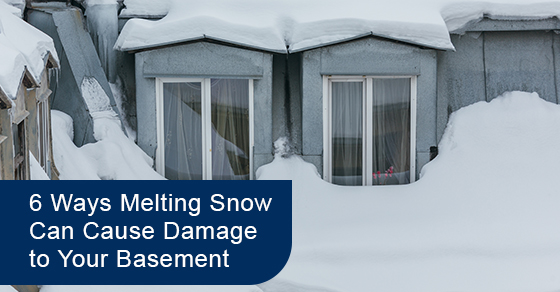 07
Mar 2022
07
Mar 2022
6 Ways Melting Snow Can Cause Damage to Your Basement
Canada can see hundreds of centimetres of snow each winter. While southern Ontario doesn’t see as much as other parts of the country, we still average 115 cm a year.
When the snow starts to melt, it can leave behind large pools of water on your property. All this water needs to go somewhere. Unless you’ve taken precautions before winter, your basement could become flooded with water, which can cause damage to your basement.
How Snow Gets Into Your basement
When the snow starts to melt, it either drains away or pools in place. Depending on the landscape of your property, melting snow could start to seep into your basement through cracks or other openings. A foot of snow is about equal to an inch of water. So, it can accumulate quickly.
The thaw/freeze cycle also allows melting snow to make it into your home. During the day, when the temperatures are warmer, the snow will melt. That water will find its way into cracks and openings in your basement. Then, as the temperature drops later in the day, the water starts to freeze.
When water freezes, it expands and it will put pressure on the materials in your basement, causing the cracks to get bigger. The next day, the cycle continues with the water melting and freezing as it moves through cracks in your foundation. As these openings become larger, more water can seep into your basement, thus causing increasing damage.
The freezing and thawing cycle can also cause damage to your pipes. If they become cracked or worn down, the risk of flooding in your basement increases. However, you can do some extra things to prevent your pipes from freezing and protect your property. Professional plumbers, like Brothers Plumbing, also offer waterproofing services.
6 Ways That Melting Snow Can Damage Your Basement
Water seeping into your basement can create a lot of problems with your foundation, and more. Here are some of the most common ways that melting snow damages your basement.
1. Foundation damage
The freeze and thaw cycle common in Canadian winters presents a challenge to the integrity of your foundation. When the water freezes and forces cracks in your foundation, it reduces the strength of the walls. It can also cause erosion of the material and presents a costly repair job.
2. Floor damage
Water that gets into your basement can damage your flooring, whether it is laminate, hardwood, or carpet. Once the water has been removed, your laminate or hardwood tiles may start to warp and bend, and the glue that held them down will likely be compromised. You may start to see tiles come out, air bubbles develop, etc. Underneath the wet carpet, mould can grow. It presents a health risk to your family, and your best option is to have your basement flooring redone.
3. Wall damage
Water leaking into your basement will drip down the walls and get into your drywall or panels. This will cause the material to break down and, with drywall, it will crumble away. Paneling may take a little longer to show the full extent of the damage, but it can rot and bend.
4. Furniture damage
If you have furniture in your basement and melting snow gets in, it may drip on the furniture upholstery, thus presenting a risk of rot and mould growth. Pooling water on the floor of your basement can damage the legs and underside of couches, chairs, etc.
5. Electronic appliance damage
Appliances in your basement, like your washer and dryer, television, game consoles, and more, can also be damaged if they get wet. It presents a risk to your safety if these items are damaged due to melting snow. That`s why protecting the items from water damage is crucial, just like how 24slots casino protects their slot machines from damage to keep their business running smoothly.
6. Storage item damage
Many of us use our basement as an extra storage area, which means we may be keeping collectables, memorabilia, and other items in boxes around the basement. If these things become wet, they may be irreparably damaged. Cardboard boxes do not keep water away from our precious memory items.
Tips to Protect Your Basement From Melting Snow Damage
No one wants to go through the hassle and expense of cleaning up after melting snow has damaged your basement. Here are some ways that you can protect your home:
- Shovel snow away from your home. Keep it a distance of about three feet from your foundation.
- Watch for snow falling from the roof. When the weather warms up and the snow starts to fall off your roof, clear it away from your foundation immediately.
- Create a path for melting snow to drain away. Make a way for the water accumulating from the melting snow to drain away from your home. This may involve digging a pathway from the water.
- Use sandbags for added protection. Sandbags can create a barrier to keep water away from the foundation of your home.
- Clear the gutters. Ensure that your downspouts and gutters are free from leaves and other debris that can prevent melting snow from draining away.
- Protect your pipes. Prevent flooding from happening inside your home by avoiding damage to your plumbing. Contact a professional plumber and have them add a level of protection with insulation or heat tape. You should also drain your outdoor faucets.
- Waterproof your foundation. Have a professional contractor examine your foundation walls and seal up any cracks or holes to protect water from seeping into your basement. This also provides an added level of strength for your foundation.
For more information about preventing your pipes from freezing or to speak with professional plumbers in Forest Hill, call Brothers Plumbing at 1-800-742-8471 or contact us here.
